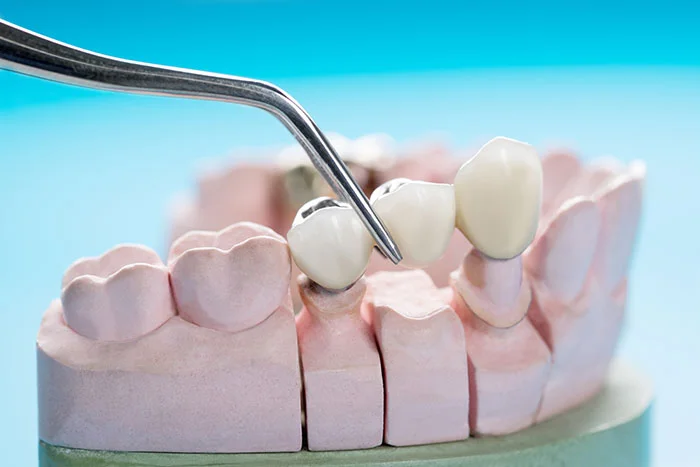Dental Crown & Bridges
Dental Crowns
To protect a weak tooth from further damage
To restore an already broken tooth or a tooth that has been severely worn down
To help support a bridge in place
To help protect a root treated tooth
After placement of an implant
To improve the aesthetics of a tooth
New technology in materials now means ceramic crowns which include Emax and zirconia crowns can perfectly blend strength with great aesthetics to restore your tooth’s shape, function and aesthetics.


Dental Bridges
Like the name suggests, is a fixed dental restoration that literally bridges the gap created by one or more missing teeth. A bridge is made up of two or more crowns for the teeth on each side of the gap.
These two or more anchoring teeth are called ‘abutment teeth. Dental Bridges are supported by natural teeth or implants.
To help complete an arch of teeth where there are missing teeth
To replace missing teeth to improve chewing
To stabilize a mouth where there are missing teeth reducing unwanted tooth movement
To improve the aesthetics of a smile
Types of Bridges:
There are a few different types of dental bridges, these are:
Fixed Bridge
The fixed bridge often offers the most retentive and natural appearance. Commonly, crowns are cemented permanently on both sides of the gap and the false tooth joins these crowns over the gum.
After the dentist has prepared your tooth for a retainer for a dental bridge, an impression of the tooth/teeth prepared is taken and the bridgework is fabricated in a laboratory for your mouth. Once fabricated, you’ll be called back for a fit appointment where the dental bridgework will be cemented into place.
Bridges can be made in various materials including metal, porcelain, and ceramic crowns. New technology in materials now means ceramic bridges which include Emax and zirconia dental bridgework, can perfectly blend strength with great aesthetics to restore your tooth’s shape, function, and aesthetics
Cantilever Bridges
As with any cosmetic treatment, at Ghauri Dental Centre we will have an initial consultation to determine whether having a dental bridge is the most suitable form of treatment to replace your missing tooth/teeth. Once the dentist has seen your teeth and determined that you should have dental bridges, it usually takes two visits to make and fit the bridge.
This first visit usually takes between 45 and 120 minutes and involves reshaping the teeth that are on either side of the gap. Local anaesthetic is often given during the reshaping of the teeth.
We also take impressions of your teeth and fit you with a temporary bridge during this first visit. This temporary bridge maintains the look and function of your teeth while the dental technician makes the bridge. A shade for the permanent bridge is chosen to blend in with existing teeth.
The second visit involves the dentist fitting the permanent bridge. The bridge is then cemented to the teeth on either side of the gap. These teeth are drilled down to attach the bridge to either side of the gap.
The middle crown is solid to mimic a tooth, the other two are hollow in order to fit over the teeth. Once treatment has taken place, the patient must be careful to clean well under the bridgework and assuming that the patient keeps the bridge clean, it should last for decades.
